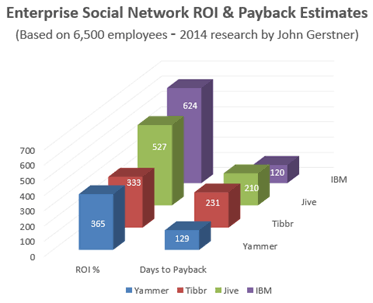
I wrote this 3,000-word article for the May, 2015 Workforce Solutions Review magazine, published by the International Association for Human Resource Information Management (IHRIM). I don’t normally write this long, but this is a topic I am deeply immersed in these days. The social organization is a journey that will touch every business, employee and department, especially HR, Corporate Communications, Marketing, IT and Leadership. Here’s my take:
The list of industries that have been radically disrupted by the Web is long and growing. Think music, travel, newspapers, taxis, books, maps and encyclopedias.
Interestingly, if you could rewind back to the genesis of each of these disruptions, you would likely find a handful of inspired and impassioned people working together in a room (or garage), in constant communication with one other and customers, partners, vendors and anyone else who might contribute to their grand quest to change the world. Think Apple, Amazon, Google, Facebook, Twitter, AirBnB and Uber.
Of course once startups grow up, they add employees and start to take on some of the bureaucratic baggage of old guard companies. Enter managers, specialists, departments, performance reviews, processes and policies.
Suddenly employees feel distanced from leadership, less in touch and less able to have their ideas heard and acted upon. They can easily lead to disengagement and, for the employees who were there in the beginning, a longing for the good old caffeine-wired, change-the-world collaborative days.
That vision of a workplace that is much more connected, inclusive, collaborative, agile and downright fun is enticing companies of all sizes to inject a new word into their workplace vocabulary: social. It’s not a perfect word to use inside organizations as it carries a lot of baggage and misconceptions, but so-called enterprise social networks (or ESNs) are fast joining the intranet as another employee go-to tools.
The ESN industry is projected to grow by 52 percent from 2012 to 2016, according to MarketResearchReports. Market research firm IDC forecasts that the compound annual growth rate in the enterprise social software category will be 42.4 percent through 2015, with worldwide spending climbing to nearly $4.5 billion in 2016.
Certainly the current workplace we all know and love to complain about is ripe for some fixing. There are way too many meetings, emails, silos, delayed decisions and micro-managers and not enough open communication, trust, collaboration, innovation and fun.
The truth, some experts say, is in the employee engagement numbers that are at or near all-time lows. Only about a third of employees are engaged, half aren’t, and 16 percent are creating trouble by being actively disengaged, according to Gallup’s February 2015 survey. And every week businesses waste 5.3 hours per person due to inefficient processes and knowledge employees spend 25 percent of their time just looking for information, according to a 2010 IBM study.
Into this mountain range of opportunity, ESNs are being trumpeted as white knights ready to rescue damsel organizations from their distress. Both McKinsey and Gartner have conducted studies on the benefits of digital social collaboration in large corporations and say these targets are achievable:
- Increased speed to access internal experts – 52%
- Increased access to knowledge – 77%
- Increase in number of successful product innovations – 28%
- Increase in employee satisfaction – 41%
- Reduced time to market – 29%
- Email reduction – 25%
If you drink the Kool-aid blend of the leading ESN vendors, you’ll hear some sweet ROI claims for successful deployment. They include seeing a 15 percent spike in employee productivity, a 2-4 percent increase in top-line revenue and a 34 percent reduction in e-mail load.
 Last year I gathered estimated ROI and days to pay back the ESN investment from four of the top vendors (IBM Connections , Jive, Yammer and tibbr) for a mid-sized company. Their estimates were strikingly similar with a three-year ROI ranging from 365 to 624 percent, and days to pay back from 120 to 231. (see chart)
Last year I gathered estimated ROI and days to pay back the ESN investment from four of the top vendors (IBM Connections , Jive, Yammer and tibbr) for a mid-sized company. Their estimates were strikingly similar with a three-year ROI ranging from 365 to 624 percent, and days to pay back from 120 to 231. (see chart)
Actually, the business case for implementing social technologies inside the workplace varies by industry. A McKinsey Global Institute report suggests that by fully implementing social technologies, companies have an opportunity to raise the productivity of interaction workers by 20 to 25 percent. That means these technologies could potentially contribute $900 billion to $1.3 trillion in annual value across the four key sectors of consumer packaged goods, retail financial services, advanced manufacturing and professional services.
Companies with the highest number of “interaction workers” —high-skill knowledge workers, including managers and professionals— can expect the highest productivity improvements through faster internal communication and smoother collaboration, according to McKinsey.
Most of the gains will come by reducing the time employees spend reading and answering email, searching and gathering information and communicating and collaborating internally. According to the study, the average interaction worker spends an estimated 28 percent of the workweek managing e-mail and nearly 20 percent looking for internal information or tracking down colleagues who can help with specific tasks.
As an internal communications manager and consultant throughout my career, I am not surprised by these numbers and the benefits of making the workplace more social. I could see the value the first week we started publishing our intranet news daily on a SharePoint blog.
Immediately, employees posted feedback to articles, and often shared nuggets of information and insight that went well beyond what we included in the story. I could see there was gold to be mined by giving pick axes to everyone in the company, not just leadership. I even chose the slogan, “All of us are smarter than one of us,” to express the vision behind my company, Communitelligence.
To better understand how ESN’s deliver business value, let’s do a head-to-head test drive of the old and steady tool what most of us still do today, email, against the new and sleeker ESN. Let’s pretend I need to find out the potential security risks of an enterprise social network and what firewalls we are using in our company today. So I compose my question and send it to the few people I know who might be able to help. And I wait patiently to see if someone responds. If they do, great, I have my answer and I can include it in my research report. If not, I’m stuck and have to go back to sending more emails and waiting.
Contrast that to putting the same request on our company’s enterprise social network. Now my query becomes part of the activity stream that is a free-flowing channel of questions, announcements, questions and ideas submitted by employees. The software allows employees to subscribe and follow communities, individuals, projects and even documents so I’m now in the know in a way not possible before. The software surfaces people, data, and applications in a central, accessible, real-time virtual interface.
So my ENS question is potentially seen by all the employees who follow network security or enterprise social networking, or IT. The chances of me getting an answer are now much higher, and it will likely be a better answer because it will be crowdsourced by employees. The thread of answers from multiple experts I never knew existed will shed new light, ask other pertinent questions and even correct earlier answers. I’ve been able to tap the wisdom of the crowd.
Plus – and this is big — now the knowledge surfaced in the thread I started is archived and easily found by other employees who might need similar information later. Compare that to the answer I might have received via email, which, incidentally is also less secure.
Even if the answer was equally solid, this knowledge is cloistered privately on my email record so no one else can benefit from the same information later and that knowledge walks out of the company when I leave. “Email is where knowledge goes to die,” is the way Bill French, founder of iPadCTO, sums up this email vs. ESN deficiency.
“Activity Streams fundamentally change how companies do business, unlocking the vast amount of information generated by everyday operations and making it instantly available across previously defined boundaries,” according to a Socialtext document. “Activity Streams humanize every business process inside a company, adding a social layer to data and opening up real-time collaboration. Activity Streams are the future of enterprise collaboration.”
“I answer one question for 18,000 people,” Bryce Williams, social collaboration at Eli Lilly told CIO magazine. “I never have to ask the same question twice. If someone asks the same question, I just link to the answer.”
There’s another subtle but critical difference between email and updates on an ESN. Email is private exchanges between individuals; ESNs are “public.” When I answer a question or post an idea on an ESN, I’m writing it for everyone in the organization.
“It’s a totally different mindset,” says Michael Idinopulos, writing on the Socialtext blog. “When I go through my emails, it’s a series of updates–usually reactive–to individuals: Don’t do this, that is approved, can’t make this meeting, missed you at that conference.
“When I go through Signals (a post in a Socialltext activity stream), it’s an opportunity to model, to muse, to question, to inspire in a uniquely public and transparent way: This is how we should think about this, help me understand that, I’m making this a personal priority, let’s celebrate the awesome job she did on that. This is work that adds to my energy, rather than taking it away.”
- Read Part Slogging Toward the Social Organization – Part 2. This article originally appeared in the May 2015 Workforce Solutions Review magazine.








1 responses on "Slogging Toward the Social Organization - Part 1"